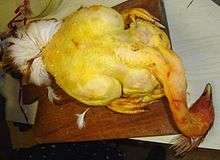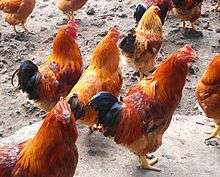Capon
A capon (from Latin: caponem) is a cockerel (rooster) that has been castrated or neutered, either physically or chemically, to improve the quality of its flesh for food, and, in some countries like Spain, fattened by forced feeding.

History
The origins of caponised chickens are contested. They were known in ancient China as well as in ancient Greece and ancient Rome.[1]
An early record of caponisation is found under the Roman Republic: the Lex Faunia of 162 BC forbade fattening hens to conserve grain rations, so the Romans instead castrated roosters, which resulted in a doubling of size.[2]:305 It was also practiced later throughout medieval times, with gastronomic texts describing capons as preferred poultry since the ordinary fowl of the farmyard was regarded as peasant fare and "popular malice crediting monks with a weakness for capons."[2]:309
France is internationally renowned for maintaining a strong caponisation tradition with widespread and established industries throughout the country.[1]
William Shakespeare mentioned capon in the famous "All the world's a stage" monologue from his play As You Like It (written c.1600). He similarly describes capon as a food of the wealthy. The monologue describes human life as consisting of seven stages, and the fifth stage is a middle-aged man who has reached the point where he has acquired wisdom and wealth. The monologue describes the fifth stage as: "The Justice, In fair round belly, with a good capon lin'd".
Effects of caponisation
Caponisation is the process of turning a cockerel into a capon. Caponization can be done by surgically removing the bird's testes, or may also be accomplished through the use of estrogen implants. With either method, the male sex hormones normally present are no longer effective. Caponization must be done before the rooster matures, so that it develops without the influence of male sex hormones.
Capons, due to the lack of the male sex drive, are not as aggressive as normal roosters. This makes capons easier to handle and allows capons to be kept together with other capons since their reduced aggressiveness prevents them from fighting.
The lack of sex hormones results in meat that is less gamey in taste. Capon meat is also more moist, tender and flavorful than that of a cockerel or a hen, which is due not only to the hormonal differences during the capon's development, but also because capons are not as active as roosters, which makes their meat more tender and fatty.[3]
Capons develop a smaller head, comb and wattle than those of a normal rooster.
Capons are fairly rare in industrial meat production. Chickens raised for meat are bred and raised so that they mature very quickly. Industrial chickens can be sent to market in as little as five weeks. Capons produced under these conditions will taste very similar to conventional chicken meat, making their production unnecessary.
Specialized production
Capons are produced in France, in several provinces, notably the Gers and Jura regions. It is a specialty of Bresse (Chapon de Bresse), where it has its own appellation to differentiate it from other capons from other regions. In Bresse, it is exclusively produced from the Bresse blue foot breed (patte bleue), and fed a certain diet which makes it even more tender than from other regions and breeds, making it a desirable meat.
Capons are also produced in many regions of northern Italy, such as Piedmont, Friuli-Venezia Giulia, Emilia-Romagna and Marche. In the early 20th century, capon was commonly eaten for the main family feast on Christmas in Tuscany and northern Italian regions, which was a rare treat for peasant or working class families.[4][5][6]
In the gastronomy of Spain, capons are usually eaten during the Christmas season in the northern regions. Capons of Vilalba, Lugo are particularly famous and are sold all over the country.
In China, capons are often raised specifically for consumption during Chinese New Year.
See also
References
- Rob. R. Slocum; United States. Dept. of Agriculture (1911-05-22). "Historical Sketch". Farmers' Bulletin. Capons and Caponizing. 452. Animal Husbandman in Poultry Investigations, Bureau of Animal Industry. University of Minnesota: U.S. Government Printing Office. p. 5.
- Maguelonne Toussaint-Samat (2009). "The History of Poultry". The History of Food. Translated by Anthea Bell (revised ed.). John Wiley & Sons. pp. 305–15. ISBN 978-1444-30514-2.
- Mrs A Basley (1910). Western poultry book. Mrs. A. Basley. pp. 112–15.
- Carole M. Counihan (2004). Around the Tuscan Table: Food, Family, and Gender in Twentieth Century Florence. Routledge. p. 61. ISBN 9781135939632. Retrieved December 15, 2014.
- Edward Giobbi; Eugenia Giobbi Bone (2005). Italian Family Dining: Recipes, Menus, and Memories of Meals with a Great American Food Family. Rodale. p. 232. ISBN 9781594861260. Retrieved December 15, 2014.
- Linda Civitello (2007). Cuisine and Culture: A History of Food and People (2nd ed.). John Wiley & Sons. p. 265. ISBN 9780471741725.
External links
| Wikimedia Commons has media related to Capon. |
- "Easy-On" Caponizing Set Surgery instructions from a home kit, published for Sears, Roebuck & Co.
